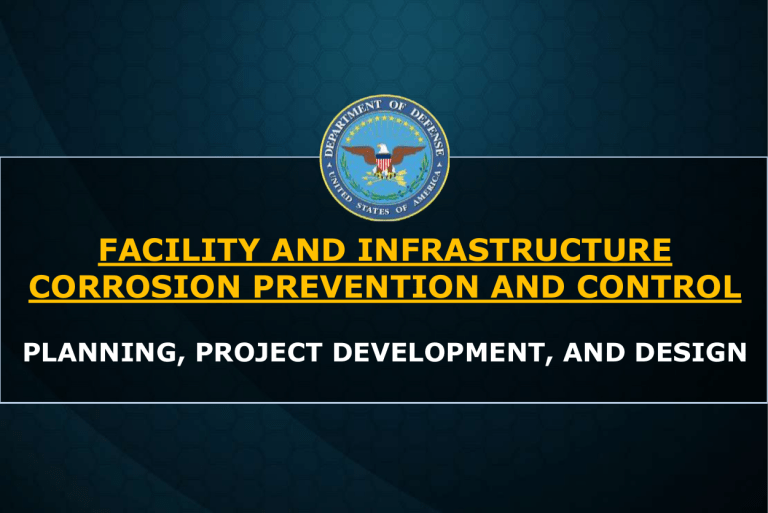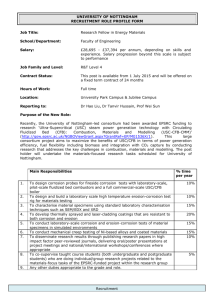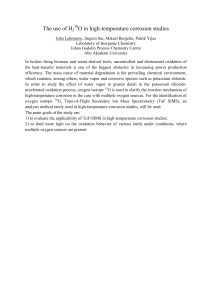FACILITY AND INFRASTRUCTURE CORROSION PREVENTION AND CONTROL PLANNING, PROJECT DEVELOPMENT, AND DESIGN

FACILITY AND INFRASTRUCTURE
CORROSION PREVENTION AND CONTROL
PLANNING, PROJECT DEVELOPMENT, AND DESIGN
Training Objectives
Training Objectives:
• Identify corrosion prevention and control (CPC) requirements and opportunities during project development for Department of Defense (DoD) facilities & infrastructure for the:
• Planning & Programming Phases
• RFP Development Phase
• Design Phase
• Identify the environmental factors which induce corrosion and the facility components which require the highest amount of sustainment resources for DoD
• Identify corrosion prevention and control criteria, design strategies, and resources available to planners. project managers, and designers to utilize on DoD facility and infrastructure projects
Importance of Corrosion Prevention and
Control During Project Development
• Importance
• Adds nearly $2B in annual facility sustainment costs across the DoD and may be as much as 40% of an asset’s life cycle cost
• Affects mission readiness – facility capacity & downtime, personnel productivity, and asset employment
• Affects safety, health, and quality of life
The DoD is required by law 1 and policy 2 to investigate corrosion prevention and mitigation strategies for enhancing the sustainability of existing facilities and ensuring the integration of corrosion prevention and mitigation technologies in newly constructed facilities and infrastructure
1 10 USC Sec 2228 and the House Armed Service Committee Report accompanying H.R. 1540, The National Defense Authorization Act
(NDAA) for Fiscal Year 2012 (H.R. Rep. No 112-78, p. 293)
2 DoDI 5000.67, February 2010, Prevention and Mitigation of Corrosion on DoD Military Equipment and Infrastructure
Definition of corrosion
– 10 USC Sec. 2228
CORROSION
The deterioration of a material or its properties because of a reaction of that material with its chemical environment.
Traditionally thought of as deterioration of metal
(e.g., rusting of steel) but includes:
• Degradation of non-metallic materials
• Rotting of wood
• Degradation of concrete
(carbonation, alkali-silica reaction phenomena)
• Degradation of composite materials
• Mold and mildew destruction of fabrics and organics
• Fluid flow, i.e. erosion corrosion
• Stressed induced, i.e. stress corrosion cracking
• Embrittlement
• Biological processes
• Solar exposure
Environmental Severity
Environmental Severity must be considered during all phases of the facility life cycle for corrosion prevention and control
•
Airborne salinity
•
Time of wetness
•
Temperature
•
Humidity
•
Pollution
•
Prevailing winds
•
Insects & fungi (mold & mildew)
•
Erosive forces – wind, wave action, fluid flow
•
UV/Solar exposure
•
Subsurface conditions
•
Submerged (e.g. water conditions)
•
Buried (e.g. soil corrosiveness)
Environmental Severity – Metals and Alloys
Airborne salinity, time of wetness, humidity, temperature, pollution, and soil PH and resistivity are the major environmental factors affecting the corrosion of metals and alloys:
• Environmental severity can vary significantly across an installation based on proximity to salt water, exposure to prevailing winds, and exposure to industrial pollutants
• Localized corrosion effects can be more important and destructive than general attack
Additional information on the environmental corrosive effects on metals and alloys can be found in the following International Organization for
Standardization (ISO) standards:
• ISO 9223 Corrosivity of Atmospheres — Classification, determination and estimation
• ISO 9224 Corrosivity of Atmospheres — Guiding values for the corrosivity categories
• ISO 9225 Corrosivity of Atmospheres — Measurement of environmental parameters affecting corrosivity of atmospheres
• ISO 11303 Guidelines for selection of protection methods against atmospheric corrosion
• ISO 11844-(1,2,3) - Classification of low corrosivity of indoor atmospheres
Planning and Programming
Project building sites and location of utility infrastructure are influenced and constrained by the installation master plan.
There are corrosion prevention opportunities in the development and modification of the installation master plan and during project site selection:
“Unified Facility Criteria” UFC 2-100-01 Installation Master Planning
―Planners will evaluate the natural environment with a particular focus on those elements that may create significant limitations on the operation, construction, or sustainment of buildings, roadways, utility systems, runways, training ranges, airfields, and other facilities.‖
Comprehensive Planning
Installation Master Plan – Corrosion Prevention Opportunities
• Identify potential for tidal and coastal flooding
• Comply with Flood Protection requirements (UFC 2-100-01 Installation Master
Planning) – ―Hazard areas must be identified during the planning process.
Executive Order 11988 requires buildings to be constructed above the 100-year flood plain elevation. 2009 changes to the International Building Code (IBC) require the use of ASCE 24 when designing buildings in a flood hazard area.‖
• Identify environmental constraints and severity (Slides 5 and 6)
• Identify installation industrial processes and contaminants. Locate industrial area and industrial buildings to minimize the impact of chemical/pollution contaminants to adjacent buildings and structures
• Mitigate the affects of buildings and structures located near salt water and with high environmental severity
• Relocate if possible
• Shelter building or structure with natural protection
• Reduce building height and orient to minimize salt fall exposure
Project Programming
Project Programming and Budget
• Verify environmental conditions and corrosion potential associated with the selected site
(Tidal and coastal flooding, environmental severity, subsurface contaminants and soil corrosiveness, & prevailing winds)
• Verify proposed building height and orientation mitigates corrosion potential for facilities and structures proximate to salt water
• Identify corrosive impacts from user operations and equipment
• Industrial processes and contaminants
• Electrolytic corrosion from external currents and bonding
and grounding of equipment
• Budget for CPC features on the DD Form 1391
• Special foundations & utilities protection (Flood and soil contaminants/PH)
• Cathodic protection if required
• Upgraded materials and coatings for enhanced corrosion prevention for sites subjected to higher levels of environmental severity – Cursor over for more detail
Design Bid Build
The majority of DoD projects use either the Design-Bid-Build or the Design-Build acquisition strategy. Although both strategies have similar requirements for corrosion prevention and control, they are usually employed in a different manner based on contracting differences.
The Design-Bid-Build acquisition strategy relies on the Scope of Architect/Engineer Services to identify the contract design requirements.
Design-Bid-Build
• Identify the need for corrosion prevention and control in the Scope of
Architect/Engineer (AE) Services
• Provide information on environmental severity
• Insure soil PH and resistivity is provided or add to scope of AE services for utility projects and buried structures
• Identify corrosive impacts from user operations and equipment
• Insure corrosion prevention is discussed at the initial design charette and implemented on the plans and specifications at each submittal stage
• Insure test requirements and quality control procedures are identified in project specification for components requiring enhanced corrosion protection and coatings
Design Build - RFP Development
Design-Build acquisition strategy is the prevalent acquisition strategy for Military
Construction Projects. This strategy relies on the Request for Proposal (RFP), to identify both the design and construction requirements
Design-Build
• Include corrosion prevention and control requirements in the Request for Proposal (RFP)
• Identify environmental severity
• Provide soil PH and resistivity information in RFP utility projects and buried structures
• Identify building components that require enhanced corrosion prevention materials and coatings. Identify the corrosion prevention and control requirements in the performance technical specifications and if necessary, mark-up guide specifications (UFGS) with prescriptive requirements
• Insure test requirements and quality control procedures are identified in the RFP for components requiring enhanced corrosion protection and coatings
• Evaluate Contractors technical proposal with CPC in mind
• Insure corrosion prevention is discussed at the design/construction kick-off meeting and implemented on the plans at each submittal stage
Design Criteria
Specify Unified Facilities Criteria (UFC) and Unified Facility Guide Specifications (UFGS) in design and construction contracts to insure CPC requirements and solutions are identified
Whole Building Design Guide http://wbdg.org
Policy Requirements –Cursor Here
UFC & UFGS
• UFC are technical manuals which define design and performance requirements, guidance, and best practices. UFGS are guide specifications which define material performance standards and in some cases, construction installation procedures. These documents are used in tandem to develop the design documentation (plans and specifications)
• UFC and UFGS rely on and reference industry consensus codes and standards
• There are thousands of corrosion prevention and control references/requirements contained throughout UFC and UFGS
• UFGS are guide specifications and are editable by the designer. As a result, there is flexibility associated with selection of corrosion prevention materials and coatings. For design-build construction, insure there is definitive language identified in the RFP for building components, utilities, and structures that require enhanced corrosion protection
Criteria Improvements
DoD representatives from the Unified Facilities Criteria Program and the Office of
Corrosion Policy and Oversight are currently reviewing opportunities in facilities criteria and tools to improve facility corrosion prevention and control.
Goals are to reduce facility sustainment requirements and improve life cycle costs
(LCC). Some areas of study are:
• The use of site environmental severity maps and indices that incorporate corrosion factors to better identify the appropriate level of corrosion protection
• Update of UFC criteria related to areas of high corrosion severity: Currently UFC 3-440-
05N Tropical Engineering
• For building components and structures that require high sustainment resources:
• Review and update UFC & UFGS requirements
• Determine LCC of enhanced CPC requirements and the use of new technologies
Design
Why design in corrosion prevention?
• Most DoD facility assets and buildings are required to have an extended service life well beyond that of commercial construction
• Most materials of construction have susceptible environments that may induce early and rapid degradation
• Maintenance, repair, and replacement of degraded components are typically more resource intensive and less LCC effective then first cost investments in corrosion prevention
Cursor over photos for more detail
Design – High Sustainment Cost Systems and
Components
Components and systems with high sustainment costs associated with corrosion:
• Building envelope - Exterior doors, windows, and roofing
• Exterior attachments- Stairways, gutters/down spouts, lighting fixtures, electrical panels, and mechanical louvers
• Interior spaces with high humidity, plumbing, and fixtures
• Interior spaces routinely open to the exterior and non conditioned spaces that are vented.
• HVAC systems
• Pavements
• Utilities and buried structures
• Waterfront and coastal structures
• Wastewater plants
Design Strategies
Design detailing and assembly of components are as important as the material and coatings for the individual component
Identify the corrosive forces and employ CPC design strategies:
• Select materials to prevent dissimilar metal corrosion
• Use protective coatings, isolators, & corrosion inhibitors
• Consider alternate materials for components proximate to salt water and in areas of high environmental severity
• Site and orient building and structures to reduce corrosive exposure
• Shelter building components to reduce corrosive exposure and time of wetness
• Prevent entrapment of water
• Insure integrity of building envelope design (UFC 3-101-01 Architecture)
• Insure moisture management and mold prevention - WBDG resource pages:
• IAQ and Mold Prevention of the Building Envelope http://www.wbdg.org/resources/env_iaq.php
• Moisture Management http://www.wbdg.org/resources/moisturemanagement.php
• Moisture Management Strategies http://www.wbdg.org/resources/moisturemanagementstrategies.php
• Moisture Management Concepts http://www.wbdg.org/resources/moisturemanagementconcepts.php
• Design-in corrosion allowance to maintain component integrity
• For exterior concrete: adjust concrete cover, mix design, and rebar material and coatings
• Consider cathodic protection (UFC 3-570-01 Cathodic Protection being revised as
UFC-3-570-01)
• Consult with subject matter experts
Paints and Coatings
Criteria and Tools
Unified Facility Guide
Spec
UFGS 09 90 00
Paints & Coatings
Decision
Tree
MPI
Master
Painters
Institute
Approved
Products
List
Architectural Painting Specification Decision Tree http://www.wbdg.org/tools/apsdt.php?c=5
UFC 3-190-06 Protective Coatings and Paints http://www.wbdg.org/ccb/DOD/UFC/ufc_3_190_06.pdf
UFGS http://www.wbdg.org/ccb/browse_cat.php?c=3
UFGS 09 90 00 Paints and Coatings
UFGS 09 96 00 High-Performance Coatings
UFGS 09 96 59 High-Build Glaze Coatings
UFGS 09 97 01.00 10 Metallizing: Hydraulic Structures
UFGS 09 97 02 Painting: Hydraulic Structures
UFGS 09 97 13.00 40 Steel Coatings
UFGS 09 97 13.15 Epoxy/Fluoropolyurethane Interior Coating of Welded Steel Petroleum Fuel Tanks
UFGS 09 97 13.16 Interior Coating of Welded Steel Water Tanks
UFGS 09 97 13.17 Three Coat Epoxy Interior Coating of Welded Steel Petroleum Fuel Tanks
UFGS 09 97 13.25 Maintenance, Repair, and Coating of Tall Antenna Towers
UFGS 09 97 13.26 Coating of Steel Waterfront Structures
UFGS 09 97 13.27 Exterior Coating of Steel Structures
UFGS 09 97 13.28 Protection of Buried Steel Piping and Steel Bulkhead Tie Rods
UFGS 09 97 23.13 Interior Lining For Concrete Storage Tanks (For Petroleum Fuels)
UFGS 09 97 23.16 Linseed Oil Protection of Concrete Surfaces
UFGS 09 97 23 Metallic Type Conductive/Spark Resistant Concrete Floor Finish
UFGS 09 97 30 Preparation of Historic Wood and Metal Surfaces for Painting
Resources – DoD Subject Matter Experts
DoD Subject Matter Experts:
• CorrDefense https://www.corrdefense.org
• US Army Corps of Engineers, Engineer Research Development Center (ERDC) http://www.erdc.usace.army.mil/
• Construction Engineering Research Lab (CERL), Champaign, IL http://www.erdc.usace.army.mil/Locations/ConstructionEngineeringResearchLaboratory.aspx
• Geotechnical and Structures Laboratory (GSL), Vicksburg, MS http://www.erdc.usace.army.mil/Locations/GeotechnicalandStructuresLaboratory.aspx
• Naval Facilities Engineering Command
• Engineering and Expeditionary Warfare Center (EXWC) Port Hueneme, CA https://www.navfac.navy.mil/navfac_worldwide/specialty_centers/exwc/products_and_services/capital_i mprovements.html
• Engineering Criteria and Programs Office. NAVFAC Atlantic, Norfolk, VA
• US Air Force Civil Engineering Center (AFCEC), Operations Directorate, Engineering Division http://www.afcec.af.mil/facilityengineering/index.asp
Other Resources
DoD Facility Criteria - Whole Building Design Guide http://www.wbdg.org
• CPC Resource Page http://www.wbdg.org/resources/cpcsource.php
• Unified Facility Criteria http://www.wbdg.org/ccb/browse_cat.php?c=4
• Unified Facility Guide Specifications http://www.wbdg.org/ccb/browse_cat.php?c=3
• NAVFAC Design-Build Performance Technical Specifications (PTS) http://ndbm.wbdg.org/system/html/6/
• Engineering and Construction Bulletins (ECB) http://www.wbdg.org/ccb/browse_cat.php?c=268
Industry:
• Master Painters Institute (MPI) http://www.mpi.net/
• NACE International (The Corrosion Society) http://www.nace.org
• SSPC (The Society for Protective Coatings) http://www.sspc.org
Training Sponsor
This training is provided by the
Office of the Secretary Defense (OSD),
Corrosion Policy and Oversight Office (CPO)
Additional corrosion prevention and control training for F&I professionals is under development and will be offered soon on the
Whole Building Design Guide







